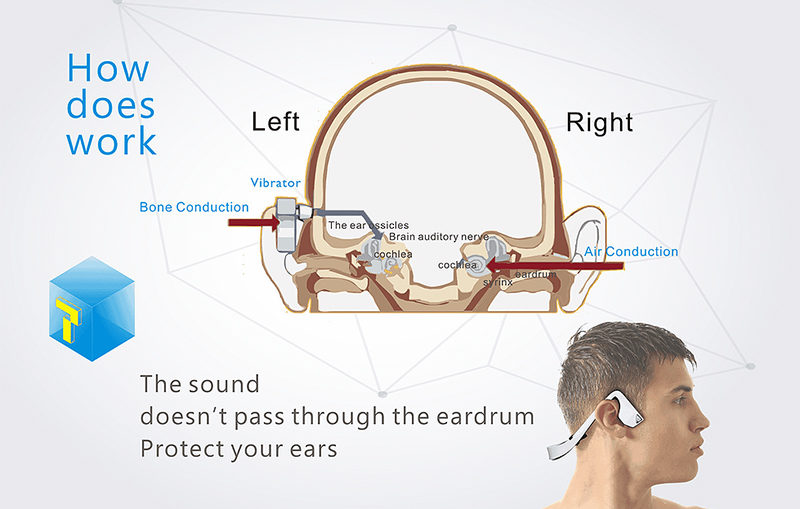Bone Conduction Technology: A New Pathway of Hearing
Who doesn’t like music? Well, that’s just a rhetorical question. Everybody likes music, one genre or the other. It’s just how our world works. We usually have earphones tucked in, volume full blast and we’re lost in our own imaginary music videos. Don’t worry, it’s universal. You’re not the only one.
With the advancement of music industry, science and technology, a crossover invention can be expected, honestly. Here comes bone conduction technology. I’ll tell you a secret; when we first heard the term, our minds instantly went to medical jargons. We thought it would be some sort of medical equipment. Oh boy, were we wrong. But with a little bit of research, test and trial on our part, we instantly became fascinated with this medical sounding bone conduction technology, partially because wow! The human body is a wonder and partially because who would’ve thought bones worked that way too.
How Does Bone Conduction Work?
Normally, fully functioning ears work with ear drums. Sound waves are vibrations in the air that travel to our ear and through to the eardrum where the eardrum feels the vibrations against its walls and interprets them into a different type of vibrations transferred to the cochlea deep inside the ear which lets us hear the sounds. Even this simple and small concept is fascinating in itself but wait! There’s bone conduction technology now.
Bone conduction completely ignores the eardrum. Poor eardrums get sidelined by the more powerful bone conduction technology. Mostly these devices or gadgets (normally headphones) take over which was basically the role of eardrums. The bone conduction devices interpret the sound waves into the vibrations fit to be sent to the cochlea and transfer them through the bones in our face, namely the cheekbones and the jaw bones to the cochlea itself which lets us hear the sounds. The technology clearly bypasses the use of the outer and middle ear and the sounds are directly chained to the inner ear.
Beethoven Was Hearing Impaired?
Have you ever thought of how the famous German composer Ludwig van Beethoven composed all the musical masterpieces when he was hearing impaired? Well, it’s largely and historically believed that Beethoven discovered the bone conduction technique by attaching a rod to his piano and fixating it between his teeth to feel the vibrations and hear the music himself.
Classy, that guy. Created masterpieces upon masterpieces despite being completely deaf.
Bone Conduction, Where?
Bone conduction technology works primarily for various groups of people in a wide range of products; hearing aid alternatives, ordinary gadgets like headphones and even deep sea diver equipment depending on the sensitivity and making of the device itself.
Initially, the bone conduction got its early usage in military communication where ambient awareness was a necessary component for survival and the bone conduction headsets provided a communication channel just as well as they opened the airways to the ambient noises for a more aware and active prospect. Later on, the bone conduction technology got its roots into hearing aid alternatives and people suffering from conductive hearing loss caused mostly by damaged eardrums started seeking assistance of bone conduction which helped them hear better bypassing the eardrums entirely. As technology grew, the deep sea divers got introduced to bone conduction technology as well for under water, the bone conduction worked tremendously for it is something whales and various other sea animals use for communication. Wonders, man, wonders!
Nowadays, the technology is also widely used in ordinary headphones just as much as sports gear. Cyclists, runners etc. prefer using bone conduction headphones as to be aware of their surroundings to avoid accidents and take in their surroundings as well.
Is it Beneficial?
When it comes to benefits, the one crucial and widely marketed benefit that bone conduction technology has and the products around it have is the ambient awareness. Since the earphones do not directly plug in as earbuds, the sounds around us are not blocked out which creates both a sense of connection just as much as the awareness of what is happening around us. It is useful around organizational environments where you can take calls, play music and listen to podcasts while being around people and interacting positively.
Another useful thing about products surrounding bone conduction is the comfort level. Earbuds fall out, headphones get uncomfortably painful after a little while. The bone conduction headphones do not. They sit comfortable and lightweight around your head without being a pain.
What are some of the best bone conduction headphones you ask?
One of the most widely used and functionally best bone conduction headphones are the AfterShokz Trekz Titanium Mini headphones. However your praises will fall short. The headphones are durable for long term use, comfortable to wear hours on end and with a battery life that is to die for.
Tested, we can say, they are extremely lightweight, you don’t feel anything when wearing them. The sounds and pitch are on point. There’s the Bluetooth connectivity that gets you going and playing music for ages. It comes with a 2 year reliable warranty. The design itself is attractive and trendy; a bonus point.
The device creates the perfect balance between ambient noise and the sounds you play to give you a safe but enjoyable trip.
For outdoors, the runner’s’ best friend is this device. The Discover Devices team of device analysts did a pretty detailed review on these things; one we religiously believed and got this one for a day to day use.
The bone conduction technology is quite possible one of the best discoveries and the inventions surrounding it are surely a masterpiece in itself.

